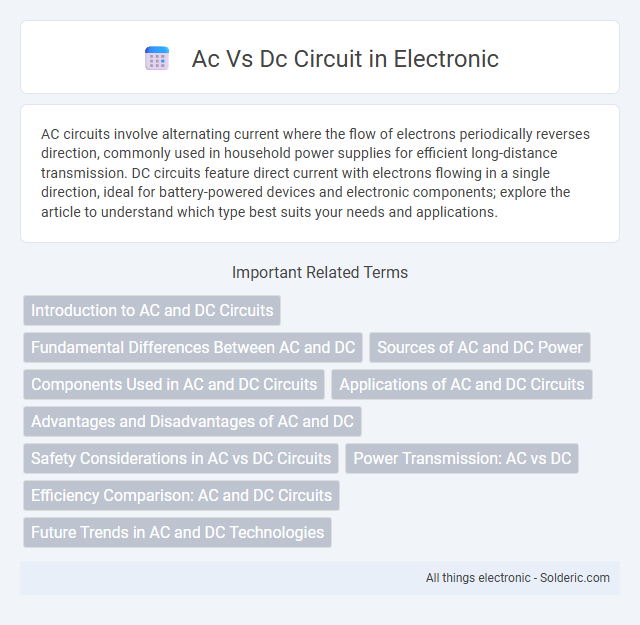AC circuits involve alternating current where the flow of electrons periodically reverses direction, commonly used in household power supplies for efficient long-distance transmission. DC circuits feature direct current with electrons flowing in a single direction, ideal for battery-powered devices and electronic components; explore the article to understand which type best suits your needs and applications.
Comparison Table
| Feature | AC Circuit | DC Circuit |
|---|---|---|
| Current Type | Alternating Current (changes direction periodically) | Direct Current (flows in one direction) |
| Voltage | Alternates in magnitude and polarity | Constant polarity and magnitude |
| Sources | Generators, electrical grids | Batteries, solar cells |
| Applications | Power transmission, household electricity | Electronics, automotive, charging devices |
| Frequency | 50 or 60 Hz (typical) | 0 Hz (steady) |
| Power Loss | Lower over long distances due to transformers | Higher over long distances |
| Complexity | Requires transformers and phase management | Simpler circuits, no phase issues |
Introduction to AC and DC Circuits
AC circuits utilize alternating current where the flow of electrons periodically reverses direction, enabling efficient transmission over long distances, commonly used in households and industries. DC circuits involve direct current with a constant flow of electrons in a single direction, essential for battery-powered devices, electronics, and automotive applications. Understanding the fundamental differences between AC and DC circuits is crucial for designing and optimizing electrical systems for specific uses.
Fundamental Differences Between AC and DC
Alternating Current (AC) continuously reverses direction, allowing efficient long-distance power transmission and easy voltage transformation through transformers. Direct Current (DC) flows unidirectionally, providing stable voltage ideal for electronic devices, batteries, and low-voltage applications. AC circuits involve sinusoidal waveforms characterized by frequency and phase, whereas DC circuits maintain a constant voltage or current in one direction.
Sources of AC and DC Power
AC power sources commonly include power plants and household outlets, generating alternating current for efficient transmission over long distances. DC power sources are typically batteries, solar panels, and fuel cells, providing constant voltage for devices and electronics. Understanding these sources allows you to select the appropriate power type for your electrical circuit needs.
Components Used in AC and DC Circuits
AC circuits commonly use components such as transformers, inductors, capacitors, and AC motors designed to handle alternating current's changing polarity and frequency. DC circuits typically feature components like resistors, capacitors, inductors, diodes, and DC motors that manage constant unidirectional current flow. Understanding these component types ensures you select the right elements for efficient circuit design and operation.
Applications of AC and DC Circuits
AC circuits are widely used in power distribution systems, household appliances, and lighting due to their ability to efficiently transmit electricity over long distances. DC circuits find applications in battery-operated devices, electronic circuits, and renewable energy systems like solar panels, where steady and consistent current is essential. Understanding these applications helps you choose the right circuit type for specific electrical and electronic projects.
Advantages and Disadvantages of AC and DC
AC circuits offer the advantage of easy voltage transformation and efficient long-distance power transmission, making them ideal for power grids and household electricity. DC circuits provide stable and consistent voltage, crucial for electronic devices, batteries, and low-voltage applications, but struggle with efficient long-distance transmission. While AC circuits can suffer from power losses due to reactance and frequency-related issues, DC circuits face challenges in voltage conversion and infrastructure complexity.
Safety Considerations in AC vs DC Circuits
AC circuits pose higher shock risks due to alternating current causing muscle tetany, making it difficult to release the source, while DC circuits typically cause a single convulsive shock. Electrical insulation and protective devices must be specifically rated for AC or DC, as DC arcs are harder to extinguish, increasing fire hazards. Proper grounding, circuit breakers, and personal protective equipment are critical safety measures to mitigate risks in both AC and DC electrical systems.
Power Transmission: AC vs DC
Power transmission using AC circuits benefits from easy voltage transformation via transformers, enabling efficient long-distance energy delivery with minimal losses. DC transmission reduces reactive power losses and offers enhanced stability for underwater or underground cables, making it ideal for specific high-voltage scenarios. Your choice between AC and DC power transmission depends on factors like distance, infrastructure costs, and application requirements.
Efficiency Comparison: AC and DC Circuits
AC circuits generally exhibit higher efficiency in power transmission over long distances due to reduced energy loss and the ability to easily transform voltages with transformers. DC circuits demonstrate higher efficiency in short-distance power delivery by minimizing resistive losses and eliminating reactive power issues common in AC systems. Advances in power electronics have improved DC efficiency, making it increasingly viable for specific applications like data centers and renewable energy integration.
Future Trends in AC and DC Technologies
Future trends in AC and DC technologies emphasize the integration of smart grid systems using advanced power electronics to optimize energy distribution and efficiency. Innovations in high-voltage DC (HVDC) transmission enable long-distance, low-loss energy transfer critical for renewable energy integration. The rise of DC microgrids and bidirectional converters supports the growing demand for electric vehicles and decentralized energy storage solutions.
ac vs dc circuit Infographic

 solderic.com
solderic.com